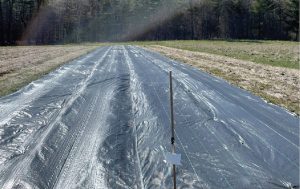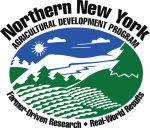NNY On-Farm Trials Show Ground Barrier May Help Reduce Damage by Swede Midge

April 29, 2025; Antwerp, Cape Vincent, Essex, NY. The Northern New York Agricultural Development Program (NNYADP) has announced the results of field trials producing the first commercial farm data and grower assessment of a new way to manage a destructive vegetable crops pest, the swede midge.
Swede midge is an invasive insect that causes significant economic damage in the brassica family of crops, including broccoli, kale, cauliflower, and Brussels sprouts. In 2024, Cornell Cooperative Extension Vegetable Specialists Elisabeth Hodgdon, Ph.D., and Christy Hoepting conducted on-farm field trials testing Hoepting’s theorized approach of using ground barriers over swede midge-infested soil to prevent the pest’s spring emergence.
“These Northern New York Agricultural Development Program-funded trials in 2024 produced the first season-long data and grower assessment of the use of a ground barrier for swede management. The data indicates that ground barriers can play a valuable role in suppressing the soilborne phase of swede midge, and may be especially useful for organic growers,” said Hoepting.
Growers participating in the trials at farms in Jefferson and Essex counties had experienced as much as 100 percent of crop loss to swede midge prior to the trials funded by the farmer-driven NNYADP.
Swede midge can be a season-long problem. The tiny fly lays eggs in the growing points of brassica vegetables. Larval feeding damages plants so they are unmarketable. The larvae overwinter in the soil to emerge the following spring and produce multiple generations until a killing frost.
Growers Appreciate Trial Results
At Chicory Hill Farm in Antwerp, silage tarp was deployed over ground where nearly 100 percent of the broccoli crop was lost to swede midge in 2023. In 2024, the tarp was applied from mid-April to July 22, 2024. No swede midge damage was recorded in June, but by fall damage was seen in cabbage, cauliflower, broccoli, and lacinato kale crops. Even so, farm owner Allen Funk said, “Even with the damage we saw in 2024, it was still less overall than that we experienced in 2023.”
Hodgdon notes, “It is not uncommon for swede midge traps to capture 100 to 200 midges per week. In 2024, trap captures in our field trials at all the participating farms did not exceed 50 midges.”
In 2023, swede midge damaged approximately 80-90 percent of the organically-grown kale crop at Riverside Farm in Cape Vincent. In 2024, the ground barrier trial there placed silage tarp over the past year’s infested kale bed from April into mid-July. Swede midge damage ranged from none in June to 32 percent in October with an increase of 44 percent mid-season in July.
“In the Cape Vincent trial, some of the kale plants appeared to have outgrown early swede damage, resulting in fewer symptoms in October versus July,” Hodgdon says.
For Riverside Farm owner Carly Basinger, “This trial showed us that using a ground barrier is one more practice we can use in an integrated pest management system.”
In Essex, organic vegetable producer Sara Kurak has battled swede midge for 10 years. In 2023, the pest damaged nearly 100 percent of the sprouting broccoli and approximately 10 percent of kale, mustard greens, and Brussels sprouts crops. From April to October 2024, Full and By Farm deployed landscape fabric over ground that had been infested with swede midge in 2023. Swede midge counts exceeded the established economic threshold of 7 males per week only twice. No crop damage was recorded in June, July, or the fall. The count peaked at only 8 percent in August.
“All three growers perceived the use of ground barriers as useful for managing swede midge as part of an integrated pest management program. In Essex, Sara also used floating row cover over most of her brassica crops to manage flea beetles during each crop cycle and so the impact of the ground barrier must be considered in tandem,” Hodgdon points out.
Research Now Expanding in NNY and Statewide in 2025
In Hoepting’s research, landscape fabric was slightly more effective than silage tarp for reducing swede midge damage, and, in trials measuring impact on swede midge emergence from soil following ground barriers application, landscape fabric resulted in greater suppression of midges versus silage tarp. This may explain the results at the Essex County farm that used landscape fabric versus the Jefferson County farms that used silage tarp.
With the foundation of the NNYADP project, Hoepting and Hodgdon secured new funding from the Northeast Sustainable Agriculture Research and Education program to continue the work with vegetable farms in Northern New York and expand on-farm demonstrations of the use of ground barriers for swede midge management statewide.
The complete report on the swede midge management research is posted as part of the NNYADP “Improving High Tunnel Production in Northern New York” report under About: Projects by Year 2024 at nnyagdev.org.
 Funding for the Northern New York Agricultural Development Program is supported by the New York State Legislature through the New York State Assembly and administrated by the NYS Department of Agriculture and Markets.
Funding for the Northern New York Agricultural Development Program is supported by the New York State Legislature through the New York State Assembly and administrated by the NYS Department of Agriculture and Markets.